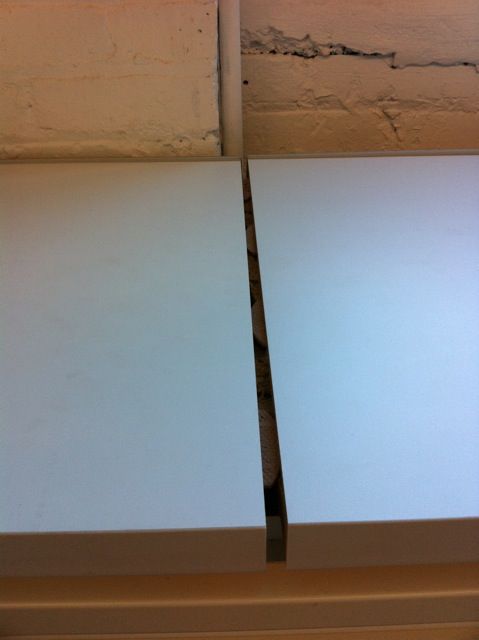Commercial Countertop Shrinkage
A very long laminate countertop in an industrial loft buildout experiences movement problems because of humidity changes. January 12, 2012
Question
Last summer we did an office build-out that involved lots of wall paneling, doors, and cabinets. We are having problems with everything shrinking and warping. Wall panels that were installed with a 2mm reveal now show a 6mm reveal. We did a 120' long plastic laminate countertop on steel brackets mounted to the wall with cut-outs around sprinkler and drain pipes. At one joint that was trapped between two pipes such that the countertop was prevented from shrinking, the forces were so great that the countertop connector bolts were ripped out.
The office has no humidity controls, and the GC is proposing to put them in now. I will be putting in a hygrometer to see exactly what the conditions are. If the humidity is brought back into a normal range (AWI specifies 25 - 55% Rh), will the panels return to their original dimensions?

Click here for higher quality, full size image
Forum Responses
(Architectural Woodworking Forum)
From contributor L:
It will take a good while, and it may not get all the way there, but the panels will approach their original sizes.
From contributor J:
Unless you know what the MC was at the time of installation, I don't think you can predict what will happen with any confidence.
From contributor O:
If the MC and the RH of the job site at install is unknown, not much to go on, and you're just guessing at the cause.
From contributor A:
Based on the looks of that wall, you are in a basement of some type. How long did your cabinets sit there before being installed? It could be there was high humidity and after they moved in and cranked the heat, everything started to move. There still might be a lot of moisture coming through that brick and being trapped behind the paneling and cabinets.
From the original questioner:
This is a commercial office, on the top floor of an old warehouse. It was fabricated and installed in the middle of a Midwestern summer, so it was fairly humid. The photo is of a section of the plastic laminate countertop. The wall paneling is installed with Z bars. Panels are approximately 4' x 8', lacewood faces, mill option veneer on the back to balance, edge banded all sides, finished both sides. The panels are restrained by the Z bars, otherwise I am sure we would see a lot of warping also. Right now the only evidence of the shrinkage is the enlarged reveals. We have a finished batten behind the reveals, so it doesn't look too bad, just big reveals.
I don't have air conditioning or humidity control in the shop, so the conditions in the shop at the time of fabrication won't always match those at the job site. How critical is it that the temperature and humidity in the shop, in materials storage, match that of the site where the goods will go?
From the original questioner:
Nothing that we built mounts to an exterior wall. This is an open floor plan with various volumes built into the space. All of these are short of the ceiling by about 6 feet. All of the interior framing is steel studs with drywall.
From Professor Gene Wengert, forum technical advisor:
Temperature is not a key by itself (except for gluing). It is all about relative humidity. But, as you heat air, the RH drops... Heat air (without adding moisture or humidifying) by about 30 F and you will drop 100% RH to 30% RH (6% EMC). (Note that this also means that a little bit of heat in storage will keep things dry; a lot of heat means very dry.) Incidentally, wood does not change its size like this except for one reason... The moisture is changing (dropping).
